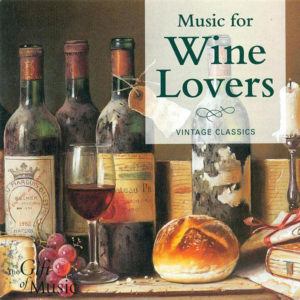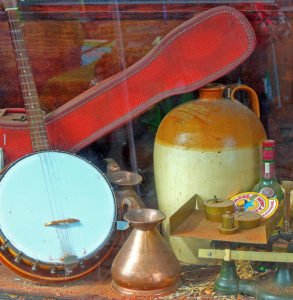The effect of music on one’s psychological behavior has been studied over and over again throughout the scientific literature. The study of music and wine as a subset is also a popular topic, one of which has seen its fair share of research. Much like wine and food, some believe that there are perfect wine and music pairings, and that maybe we might see music playlists paired alongside the wine lists at a restaurant.
Studies have found specific musical pieces seem to pair well with certain wines, and that in general, wine seems to be more enjoyable when there is music playing in the background compared to drinking in silence. (Click here for a post I did 6 years ago on the topic of wine and music).
While there is a lot of research showing that music does, in fact, influence the taste and/or enjoyment of a given wine, very little is known about exactly how or why this behavior occurs. Some research in related fields suggest that this wine-music relationship, which is considered

Photo courtesy Flickr user iClassical Com
a “cross-modal correspondence”, could be driven by emotional responses. These types of emotional responses have been seen in research related to sound-taste, color-sound, color-odor, sound-odor, and shape-taste correspondences, which would suggest that the wine-music correspondence may also be controlled by emotion.
A new study, published in the journal Beverages, aimed to build upon this research and evaluate whether there are shared emotional associations between wine and music and if these associations drive an individuals’ evaluation of the wine-music pair.
Brief Methods
Three classical music pieces were chosen for this study, all of which varied in tempo, key, and instrument make-up.
-
- Sophia Giustani Dussek’s “Harp Sonata in C Minor”: fast tempo, major key.
-
- Sergei Rachmaninoff’s “Romance”: slow tempo, minor key.
-
- Carl Off’s “Carmina Burana”: medium tempo, minor key.
Three red wines were selected for this study, all of which varied in body, acidit, and tannin levels. The authors noted that only red wines were selected, to avoid any preferences for white or any serving temperature differences, as these could potentially muddle the results of the study.
- Domaine Pellé Menetou-Salon Morogues Pinot Noir, 2014: light body, soft tannins, high acidity.
- The Society’s Blind Spot 2014 Grenache Shiraz Mataro (GSM): full body, soft tannins, low acidity.
- Scacciadiavoli Montefalco Rosso, 2012: full body, big tannins, high acidity.
Participants sat in front of a computer in a dimly-lit sound-proof room.
The study consisted of three “blocks”:
- Block One: Each music selection was played once while participants tasted all three wines in random order. Participants were asked to rate each wine a score from 1 to 10 based on how well they thought it matched to a specific piece of music.
- Block Two: No music was played. Participants were tasted to taste the wines and rate how much they liked them on a 1-10 scale, and then were asked to rate how much the wines elicited specific emotions (valence: sadàhappy, arousal: calmàexciting, dominance: weakàpowerful).
- Block Three: Each music selection was played in random order and participants were asked to rate how much the musical numbers elicited specific emotions (valence: sadàhappy, arousal: calmàexciting, dominance: weakàpowerful). No wine was tasted.
Selected Results
- 21 people participated in this study (10 females, 11 males).
- Participants were between the ages of 22 and 63.
- 4 participants self-identified as beginners, 8 as intermediate, and 9 as experts. (Note: to be considered experts, all you needed to have was over two year wine tasting experience or be employed in the wine industry).
- The “Harp Sonata in C Minor” was the worst match for all three wines.
- The Montefalco Rosso wine was better paired will all three music selections when compared with the Pinot.
- For the Blind Spot GSM, “Romance” was the best paired musical selection.
- For Montefalco Rosso, “Carmina Burana” was the best paired musical selection.
- The Montefalco Rosso wine was rated as eliciting the greatest emotional associations for “exciting” and “powerful”.
- The Pellé Pinot Noir was the least liked of the three wines.
- Rachmaninoff’s “Romance” was rated as eliciting the greatest emotional associations for “sad”.
- Off’s “Carmina Burana” was rated as eliciting the greatest emotional associations for “exciting” and “powerful”.
- Further analysis suggested that the emotional dimensions of dominance (weakàpowerful) and arousal (calmàexciting) drive wine-music matches/pairing to a certain extent.
- When comparing wine beginners/intermediates and wine experts, results indicated no differences in ratings for wine types or music types.
Conclusions
Overall, this brief study confirmed what is already known about wine and music and that certain songs seem to “pair” well with certain types of wines. Additionally, the results seemed to support the idea that emotions might, at least in part, drive cross-modal correspondence or preference for a certain music and wine pairing type. In other words, people are more likely to prefer a wine-music “pairing” where the wine and musical number share similar emotional response ratings.
If these results are “accurate”, then it may be possible to come up with the “perfect” playlist for a wine tasting event. Granted, one would have to figure out how to make sure the specific wine is being tasted at the same time as a specific musical number is being played, but in theory it could be possible. It partially depends on the variety of the wines available for tasting—the more similar the wines, the easier it would be to come up with a playlist that doesn’t rely as much on timing.
Of course, the results of this study really should be taken with a huge grain of salt.

Photo courtesy Flickr user psyberartist
First: the sample size was tiny. Certainly, there must be some sample bias here, as it is unlikely that the likes and preferences of 21 individuals exactly mirrors that of the entire population. A larger sample size would be helpful in a follow-up study.
Second: the wines and musical numbers were not all that dissimilar from one another. Sure, there were some obvious differences, but the researchers did admit that the “liking” scores and some of the emotion scores between some wines and some songs were not all that different. A wider selection of wines and songs with greater differences between them might be helpful in a follow-up study.
(Note: there are likely several other issues with this study that I won’t bore you with now, but would encourage you to discuss in the comments if you wish!).
To conclude, overall this study took a brief glance at the relationship between wine and music pairing and emotion, and how emotion may drive the “perfect pairing” of the two. I was not at all surprised by the results, and would be interested to see how this research progresses in the future.
Source:

1 comment for “Wine and Music “Pairing” Preferences Driven by Emotion: A [Very] Brief Look”